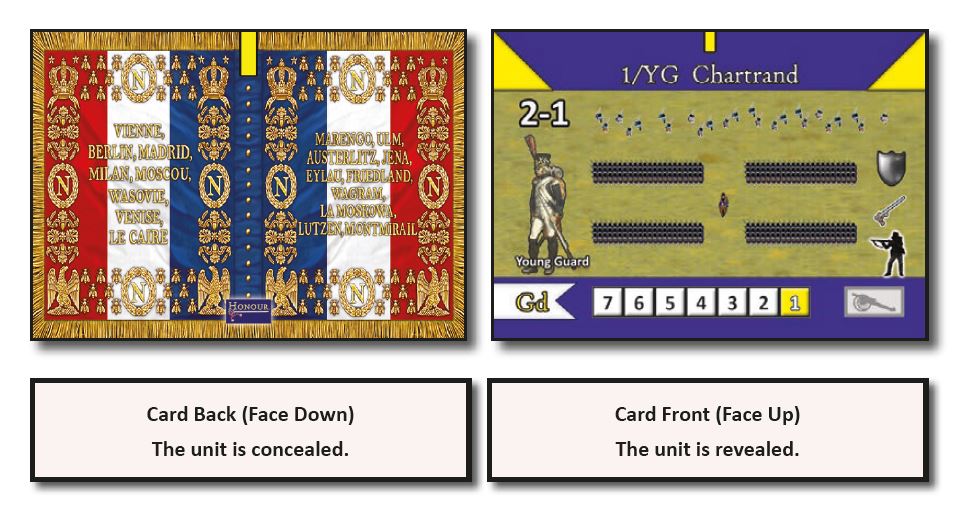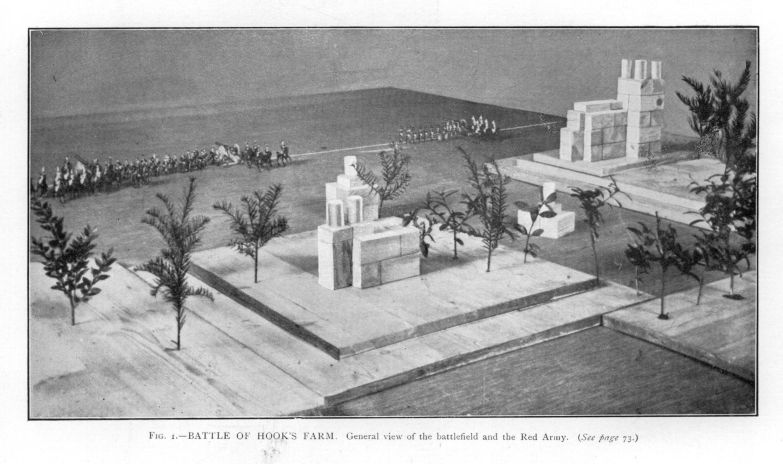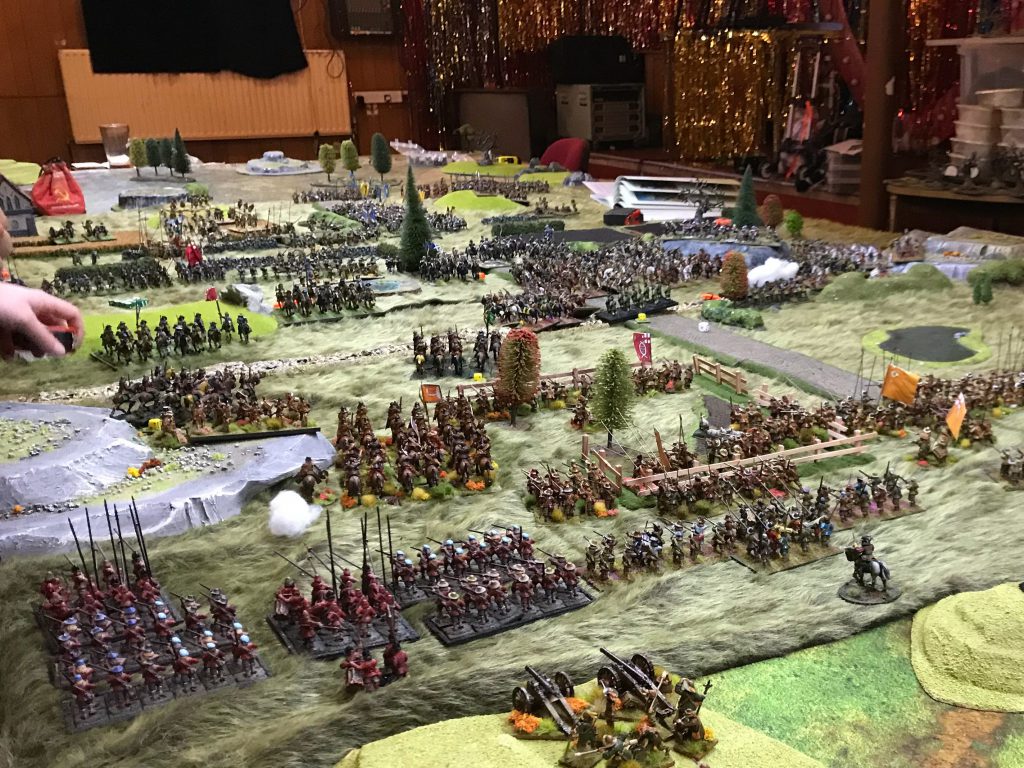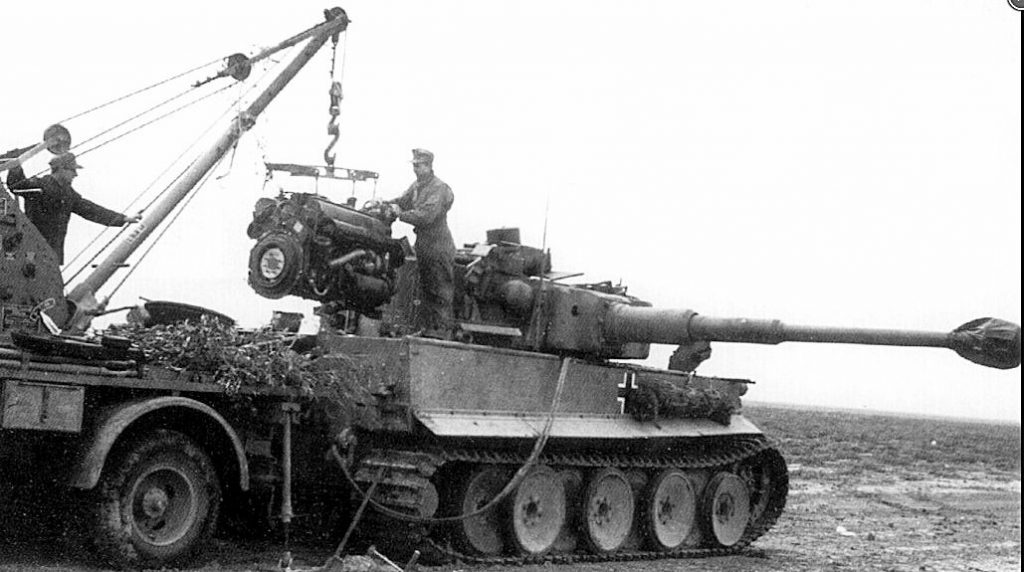Welcome to Historical Roundtables, our regular column where the Goonhammer Historicals team gets together to talk over a particular aspect of historical wargaming. They’ll share their insights, recommendations and warnings about the best way to engage with the hobby. This week we’re looking at deployment, making sure your army is in the right place, potentially at the right time.
Is Deployment in Historicals just like in any other game system?
Lenoon: I’m fairly new to historicals gaming, and really jumped into it for the first time just pre-pandemic. I was surprised to see that the phase I thought least about in my sci-fi gaming was a huge creative space. I’d read the guides to deployment in 40k, and used to love the classic refused flank in Warhammer Fantasy, but hadn’t thought about the mechanics of deployment at all. Being a giant nerd, I went right back to the beginning, and was surprised to see that lots of the conventions of deployment I was used to came from HG Wells’ 1913 Little Wars ruleset. Alternating deployment, a “deployment line,” and even deploying for advantage all begin there; with only a few details changed, 9th edition 40k deploys exactly as Jerome K Jerome and HG Wells did on the drawing room floor with 54mm tin miniatures. The amazing thing with the sheer variety of rulesets in historicals – particularly since the boom in well produced, playtested indie games, and the plethora of innovative and challenging game designers out there – means that even deployment has started to open up into an interesting space.
Ilor: The kind of deployment we see in many (if not most) wargames where each side lines up on their own side of the table and you both go at it absolutely harkens back to the dark ages. What I find surprising is that it’s not the modern sci-fi and fantasy games in which we’ve seen innovations in unit deployment – 40K for instance is thoroughly “traditional” in this regard even after 9 editions – but rather in historicals themselves. And I know we rave about Too Fat Lardies a lot (and with good reason), but they have led the charge on bringing new deployment mechanics into play. Whether it’s the claustrophobic paranoia of the Deployment/Ambush style the barbarian forces can use in Infamy, Infamy, the gambled uncertainty of the Moveable Deployment Point in Sharp Practice 2, or the sheer magic of the Patrol Phase in Chain of Command, TFL has really raised the bar when it comes to novel innovations in force deployment.
Lupe: It’s not just TFL – historicals have a huge range of different mechanics, and some of it is extremely different to what we see in a lot of sci-fi and fantasy wargames. I’ve played historicals where no units start on the table, where I didn’t know what units I had to play with when the game began, where I didn’t know what units my opponent had until they revealed themselves, and many more unusual things. Deploying in more standard land conflicts is extremely varied, but when you get to naval and aerial battles everything is on the table as a possibility.
Mugginns: I think if you wanted to find a historical game with standard deployment where you have all the information and can see everything, you definitely could find it.
The key differentiator as has been said already is that there are so many other types of deployment methods, and many of them aren’t there just to make a cool game, they are there to represent the time period/tactics. As an example, in Bolt Action you oftentimes have a small force on the board to start the game and then roll on reserves later – representing a small action to start with between a squad or two which develops into a bigger battle as communications are used to call in more troops.
What specific issues and challenges do deployment mechanics in historicals face?
Lenoon: Depending on the period and scale, you might be deploying within, or outside, of effective missile range. That’s a big, big deal, and it means that deployment rules can be a little more consequential in some periods than others. Any game where you’re chucking volumes of 28mm scale lead several feet needs mechanics that don’t lead to just two lines of models shooting at each other while rooted to the spot. Traditional “deployment zones” stop being useful as soon as the overall tactical aim is to walk your line up to another line and start shooting. This is actually something that always irked me in 40k and Fantasy – if you’re deploying at missile range, you may as well abstract your bows or bolters out, they’re just sitting there until they run out of things to shoot, or get hit.
Ilor: Another thing that you have to be cognizant of in historical games is ground and/or figure scale. Most sci-fi and fantasy games live at the roughly 25mm-32mm figure scales, so the size of the battlefield represented by the table is relatively small. But historical wargames run a much wider span of figure and ground scales, with stuff as small as 2mm being used to represent massive battles in the ancient world.
Further, when you’re talking about warfare prior to radio communication, sometimes the hardest part of the fight wasn’t actually the fight itself, but getting your troops where they needed to be. If the era of your historical wargame includes this aspect of commanding your troops then you need to have room to meaningfully maneuver (or fail to meaningfully maneuver). But since movement-to-contact is the most pointless and boring part of any wargame, a good deployment system can go a long way to getting to the fun stuff as quickly as possible.
Lupe: One of the biggest challenges, as Ilor has alluded to, is how deployment is influenced by the era and the kind of battle being had. Everything neatly arriving in a line is sensible for one era, but nonsense for another, and so historicals need to consider the historical context of getting people to the battle. Which means, and I’m going to drop the L bomb here, you need to think about logistics.
Deployment is, ultimately, the on-table expression of logistics and operations. How many troops have you managed to get to the battle, and how are they arriving, and in what way? How do you represent that without the whole thing becoming an abject nonsense, as models pop up all over the place and everyone is confused (which is, perhaps, historically accurate).
Let’s consider one of the biggest challenges in deployment: asymmetrical warfare. If we think of something like insurgency tactics in Afghanistan or Iraq, you can immediately see some of the huge challenges presented. Let’s imagine a US patrol in an area that’s going to be ambushed. One force is going to be moving into the area relatively openly, while the other is going to be hidden and concealed until the moment they strike. As Ilor says, you don’t want to have the US player manoeuvring around for ages waiting for something to happen, but equally the ambush is a key part of how the insurgents might actually win. If you abstract it away, just throw models on the board, then you’ve effectively handed the day to one side immediately. But then, how do you represent troops on the board when their location not being known is their key advantage? These kinds of challenges are a huge problem in historical wargaming.
Ilor: Absolutely. And in many ways this ties back to our previous discussion of force selection – Do you reflect the gas-guzzling, mechanically unreliable German “big cat” tanks by making them more resource intensive to purchase during force selection, or by giving them some sort of deployment handicap? Like, “Sure, you can have a Panther. But you don’t have any gas for it, so once you actually put it on the table it’s effectively immobile.” Or maybe both?
Mugginns: The only thing I can think of is sometimes the Fog of War or random nature can be a tough challenge for people who are newer to historical gaming.
If half your force is in reserve, or all of it, and you have to roll to bring them on, or flip a certain card, it can be demoralizing to play the game with only some of your troops. I don’t think developers should move away from this type of mechanic – I think it definitely works great – it can just be a hard time once in a while for newer players.
It also does help, sometimes, because your opponent doesn’t get to pick and choose who they’re going to annihilate this turn because the thing they want to kill is not on the board yet.
What’s the best/most enjoyable/most interesting deployment mechanic you’ve come across?
Lenoon: I like any mechanic where you can deploy with hidden information. That might be deploying behind a curtain or a big pile of boxes, but best of all is not deploying any units in the first place. Blucher (the wargame, rather than the general) has you deploy cards which show only national characteristics – they can be revealed (flipped to the information side) by movement or firing, and your opponent can discover them to find out exactly what they are. It’s a simple and effective way to do hidden information deployment, opens up the possibility of complex plays, redeployment and refused flanks, and has a simple and effective mechanic behind it. If the cards could move – with line of sight rules governing when they’re revealed – it’d be perfect (someone is going to comment and tell me I’ve been reading the rules wrong and you can do that, I’m sure). It’s analogous to Space Hulk/GSC blips – Napoleonics, but if the Austrians had 4 arms tipped with ceramite-shredding talons.

Ilor: I’ve said it often, but Chain of Command’s “Patrol Phase” is amazing. It gives you a general sense of the parts of the table from which the enemy might deploy, but usually your first inkling that an enemy unit is present is when it pops up and shoots at you (as you can fire during the phase in which you deploy onto the table). This captures the feel of the “empty battlefield” exceedingly well. It’s also great because differences in how the Patrol Phase plays out can result in significantly altering the feel of the game even if you’re reusing the same forces and replaying on the same table. I have a Sicily scenario I’ve brought to a number of conventions (both in-person and virtual) and the 8 or so plays of that scenario have been very different from each other.
Lupe: I like the Patrol Phase, but for my money my favourite is actually in another TFL game, Infamy Infamy. I’m not going to rehash it all here because I wrote about it at length in my review of that game but the ambush/deployment point mechanic is absolutely wonderful and is the best solution to that asymmetrical warfare issue I mentioned above I’ve seen.
I also like the simplicity of Saga, where the person to deploy first puts half their force down, their opponent deploys it all, and then they deploy the rest. It’s a nice balancing mechanic for static deployment that makes it much less one sided in execution.
Mugginns: I can echo all the stuff said above, but I think my favorite is Bolt Action – for many missions you start with some of your stuff on the board, but the rest comes on in the Second Wave or you roll for them to come on. I think it’s a good way of introducing players to a historical mindset without going too far.
I often see people online referring to BA as ‘WW2 40k’ or some such but I don’t think that’s fair. The game has a lot going for it and is different in almost every mechanic from 40k, but is still welcoming and a good transition for players looking for something else.
Like a paratrooper dropping into a pine forest, which mechanics just don’t work for you?
Ilor: As a huge TFL fan it saddens me to say one of my least favorite deployment mechanisms comes from Chain of Command, and that’s the Pre-game Barrage. By the Second World War, artillery fire was generally used not on the enemy’s front line positions directly (which were usually well dug-in and thus more protected from indirect fire), but rather on their staging/form-up/command areas, as this tended to be much more disruptive to the enemy’s ability to make a swift response and/or stage a counterattack. In Chain of Command this is represented via a Support option that forces your opponent to roll a 4+ on a d6 every time they want to deploy a unit onto the table (and recall that in CoC, the game almost always starts with no units of either side on the table). While this absolutely has the intended effect of disrupting the enemy’s ability to effectively respond, it kind of has a “feels bad” aspect to it because it can effectively prevent a player from being able to participate in the game. If you consistently roll for crap, there’s a possibility the game might be over before you deploy any units on the table. Given the number of rolls you’ll make in any given game (and the fact that the barrage can be ended under certain conditions) this outcome is highly unlikely, but it still feels a little un-fun.
Lupe: It’s always a little disheartening for me when I play a game of Black Powder or Hail Caesar (from Warlord Games) because it’s just so… lackluster. It’s the epitome of “line up all the little men and run at each other” deployment, but what really gets me is that there are lots of much more interesting deployments (albeit static) to be found in the example scenarios throughout their books. However, these have no mechanics to them, and instead players are encouraged to “do what seems right” which to me feels like an abdication of responsibility on behalf of the designer. I want some mechanics, you know, not just to be told to go and work out the mechanics on my own.
Lenoon: Lupe you’re dead on – “For the moment, it suits our purposes to imagine that each side has deployed on opposite sides of a typical table or area of floor, at least three feet apart if possible” is the limit of generic non-scenario deployment info in Black Powder. The scenarios hint at some really interesting deployment ideas, but there’s no info on how to extrapolate that out. There’s a presumption that everyone will sit down and hash out something interesting and wonderful, but until you’ve played a period, and a system and your opponent a fair bit, working something up out of whole cloth is not just intimidating and time consuming, but might not even be possible. It’s HARD to come up with balanced, thematic and appropriate methods of deployment – if the game designers don’t, what chance do you have to do so on the fly?
Mugginns: I’m not huge on hidden deployments. I love Deployment Points in Sharp Practice or Chain of Command, I just don’t enjoy moving around tokens that may or may not represent troops. It may be more representative of the period, it may be better for tactics, but I just can’t do it.
What would you add to deployment mechanics?
Ilor: I’d really like to see a deployment system where the players can spend some of their force selection resources to either aid their own deployment (bigger zones, more or different board edges or deployment points, faster deployment, etc) or disrupt their opponent’s (compressed zones, limited axes, delays, or troops arriving disrupted/exhausted). I once put together a home-brew, after-market, bolt-on campaign system that incorporated a number of these elements for ACW games (I was using Gettysburg Soldiers at the time), and that could produce games that were much more dynamic than the kind of “line up and shoot” games that so many of the more traditional games generally offer.
Lupe: I’ve read Ilor’s homebrew and it really hits a lot of good notes, and I’d echo a lot of his thoughts here. I would also, however, really like to see some mechanics to represent ambushes and secret maneuvers that happen after initial deployment. We have some, but they’re not really baked in as well as they could be. I’d love to have some kind of mechanic that lets you buy “tactics” or “gambits” that included things that Ilor mentioned, but also included things like “secret unit hidden in a forest” and “unit is circling round and will come on in the second turn from a different board edge” and so on. That would be a really cool thing to add a lot of dynamism during play as well as at the beginning of the game.
Lenoon: I like the idea of some kind of buy-in for tactics and deployment shenanigans, you could even theme it to the armies you’re playing which would be a quick way of making every game asymmetrical, something really considered and balanced with army lists. Maybe your Romans can’t buy the pop out of a forest option, but they can buy a forced march up the table.

For more deliberately symmetrical armies – say my French Guard against some Hohenzerhollen and Hapsburg reactionaries – I quite like the idea of almost doing it the other way. The units you actually deploy are all the ones that deploy with gambits or tactics, and the lines smashing against each other or firing blind into the gunpowder haze are deployed in matched pairs. You have to deploy a certain weight of line and your opponent has to match it. Or go even further and completely abstract them out. Yes the phalanx is going to painfully advance into the other phalanx for example, so maybe that’s not even a deployment choice but a feature of the game. The game happens around a large, moving terrain feature that’s the deployed and order locked infantry. I dunno I probably need to think about that more.
Lupe: That’s a very interesting idea. Ultimately a lot of games end up being “these two lines of troops smash into each other” and jumping straight to that and then saying “OK, but the interesting bits are where that doesn’t happen” appeals strongly to me. There’s something very compelling there I think. It probably works better for eras where you’re not going to be shooting at each other as much as meeting at the line of battle, but then “engaging” is a fuzzy concept anyway. I quite like tying this into morale too – the line gets set up, and then it’s the gambits and tactics around the line that determine the overall morale of that line, and when the line collapses you’ve lost. Having a unit with a tactic that lets them rush up and reinforce. A cavalry column that has a tactic to let them encircle and charge at a flank. A hidden ambush from some grenadiers that threatens the artillery supporting the line.
That’s potentially very interesting, but probably strays us away from deployment and into a different subject that we should have a separate discussion about…






